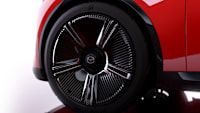Infiniti’s revolutionary VCT engine set for Paris debut next month.
Bringing a variable compression ratio engine into the market has been one of biggest challenges in the history of engine development, but Infiniti has succeeded.
Christened the VCT, their new 2-litre four cylinder petrol turbocharged engine is said to be the first production-ready variable compression ratio engine in the world, which they will be giving its public debut at the upcoming Paris motor show at the end of September.
According to Infiniti, the VCT engine was the result of more than 20 years worth of development with more than 300 technologies patented for use in the engine. Unlike an Atkinson cycle engine, which has two different fixed compression ratios depending on piston’s cycle, the VCT is able to adjust its compression ratio anywhere between its lower limit of 8:1 and higher end of 14:1.
The VCT engine is able to maximise its efficiency by running a higher compression ratio at idle or low speeds, and boost performance by switching over to a lower compression ratio under hard acceleration or heavy engine loads. All seamlessly at the behest of the driver’s demands.
According to Infiniti, the engine’s intrinsic smoothness allows it to achieve the NVH levels similar to that of a V6 engine.
Infiniti claims that thanks to the VCT’s trick system, it is able to deliver the power of a high performance 2-litre petrol engine and even match ‘certain’ six cylinder petrol engines, with the torque and efficiency of a modern turbo diesel without the bothersome emissions.
Where normal engines have the connecting rods attached directly to the crankshaft, the connecting rods in the VCT are attached to a multilink bracket on the crankshaft on one end.
Attached to the other end of the bracket is a lever arm that is connected to what Infiniti calls a ‘Harmonic Drive’ actuator.
By rotating and adjusting the angle of the multilink bracket, the actuator is able to lower or raise the height of the piston’s reach, which in turn decreases or increases the compression ratio accordingly.
With a variable compression ratio engine, engineers aren’t limited by fixed compression ratios when it comes to extracting more power and achieving better efficiency, especially when it comes to modern turbocharged engines. A high compression ratio allows a leaner burn, thus achieving better efficiency, at lower engine speeds. The downside of this however means that the engine has a danger of ‘knocking’ or premature combustion of the fuel/air mixture in the combustion chamber which can cause engine damage. Modern engines avoid this situation by retarding the engine’s timing, at the expense of its power output.
Add a turbocharger to the mix and the extra volume of air forced into the combustion chamber by the turbocharger effectively increases the pressure inside. As such turbocharged engines are designed with a lower compression ratio to avoid ‘knocking’. This however means that at moments when the turbocharger is not sufficiently spooled up to force the necessary volume of air into the engine at low engine speeds, the engine won’t be able to run efficiently.
The new Infiniti setup also limits the lateral movement of each piston to promote smooth running. Because the connecting rods aren’t directly connected to the crankshaft, Infiniti has been able to meet NVH targets without using a balance shaft as commonly found on fourcylinder engines.
According to Infiniti, the engine’s intrinsic smoothness allows it to achieve the NVH levels similar to that of a V6 engine.
To further boost efficiency and power, and ensure that they have all bases covered, the VCT is crammed full of other advanced technologies. It is said to employ both multipoint injection and direct injection, an electronically controlled wastegate actuator to maintain turbocharger boost pressure, Infiniti’s lowfriction ‘mirror bore coating’, and able to switch between both Atkinson and regular combustion cycles.
For now though Infiniti is keeping mum on the engine’s finer details like power output and consumption figures, and just what models it will be fitted to until it's official debut at Paris.
The first production models to use the Infiniti VCT engine are set to hit the road in 2018.
Do you find VCT tech impressive or do you think electric drivetrains are the future? Tell us what you think in the comments below.









.jpg)




.jpg)

.jpg)
.jpg)
.jpg)
.jpg)
.jpg)
.jpg)






.jpg)
.jpg)
.jpg)
